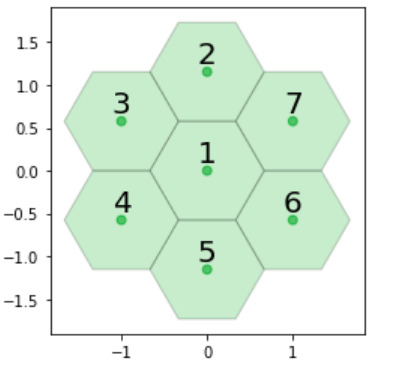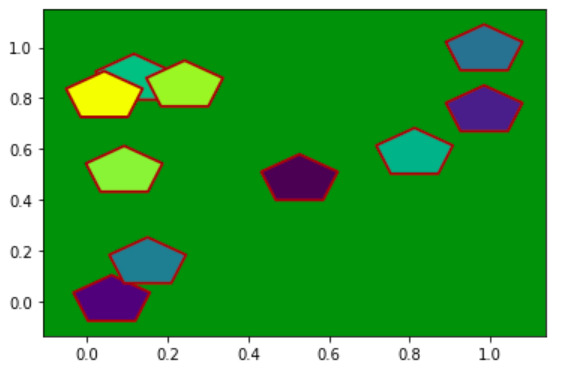Matplotlib是Python中令人惊叹的可视化库,用于数组的二维图。 Matplotlib是一个基于NumPy数组的多平台数据可视化库,旨在与更广泛的SciPy堆栈配合使用。
matplotlib.patches.RegularPolygon
这个matplotlib.patches.RegularPolygon类用于添加常规多边形面片。
用法: class matplotlib.patches.RegularPolygon(xy, numVertices, radius=5, orientation=0, **kwargs)
参数:
- xy:中心的长度2个元组(x,y)。
- numVertices:它表示顶点数。
- radius:从中心到每个顶点的距离。
- orientation:用于旋转多边形(以弧度为单位)。
下表列出了有效的kwarg;
| PROPERTY | DESCRIPTION |
|---|---|
| agg_filter | 一个过滤器函数,它接受一个(m,n,3)浮点数组,一个dpi值返回一个(m,n,3)数组 |
| alpha | 浮点数或无 |
| animated | bool |
| 抗锯齿或抗锯齿 | unknown |
| capstyle | {‘butt’,“回合”,‘projecting’} |
| clip_box | Bbox |
| clip_on | bool |
| clip_path | [(Path,Transform)|补丁|无] |
| color | rgba元组的颜色或顺序 |
| contains | callable |
| edgecolor或ec或edgecolors | 颜色或无或‘auto’ |
| facecolor或fc或facecolors | 颜色或无 |
| figure | figure |
| fill | bool |
| gid | str |
| hatch | {‘/’、‘\’、‘|’、‘-’、‘+’、‘x’, ‘o’、‘O’、‘.’、‘*’} |
| in_layout | bool |
| joinstyle | {‘miter’,“回合”,‘bevel’} |
| 线型或ls | {“-”,“-”,“-。”,“:”,“,(偏移量,on-off-seq),...} |
| 线宽或线宽或lw | 浮点数或无 |
| path_effects | AbstractPathEffect |
| picker | 无或布尔或浮点数或可赎回 |
| path_effects | AbstractPathEffect |
| picker | float或callable [[Artist,Event],Tuple [bool,dict]] |
| rasterized | 布尔还是无 |
| sketch_params | (比例:浮点数,长度:浮点数,随机性:浮点数) |
| snap | 布尔还是无 |
| transform | matplotlib.transforms.Transform |
| url | str |
| visible | bool |
| zorder | float |
范例1:
import matplotlib.pyplot as plt
from matplotlib.patches import RegularPolygon
import numpy as np
coord = [[0, 0, 0],
[0, 1, -1],
[-1, 1, 0],
[-1, 0, 1],
[0, -1, 1],
[1, -1, 0],
[1, 0, -1]]
colors = [["Green"],
["Green"],
["Green"],
["Green"],
["Green"],
["Green"],
["Green"]]
labels = [['1'], ['2'],
['3'], ['4'],
['5'], ['6'],
['7']]
# Horizontal cartesian coords
hcoord = for c in coord]
# Vertical cartersian coords
vcoord = [2. * np.sin(np.radians(60)) * (c[1] - c[2]) /3.
for c in coord]
fig, ax = plt.subplots(1)
ax.set_aspect('equal')
# Add some coloured hexagons
for x, y, c, l in zip(hcoord, vcoord, colors, labels):
# matplotlib understands lower
# case words for colours
color = c[0].lower()
hex = RegularPolygon((x, y),
numVertices = 6,
radius = 2. / 3.,
orientation = np.radians(30),
facecolor = color,
alpha = 0.2,
edgecolor ='k')
ax.add_patch(hex)
# Also add a text label
ax.text(x, y + 0.2, l[0], ha ='center',
va ='center', size = 20)
# add scatter points in hexagon centres
ax.scatter(hcoord, vcoord, c =.lower()
for c in colors],
alpha = 0.5)
plt.show()输出:

范例2:
import matplotlib.pyplot as plt
from matplotlib.patches import RegularPolygon
from matplotlib.collections import PatchCollection
import numpy as np
xy = np.random.random((10, 2))
z = np.random.random(10)
patches = [RegularPolygon((x, y),
5, 0.1)
for x, y in xy]
collection = PatchCollection(patches,
array = z,
edgecolors ='brown',
lw = 2)
fig, ax = plt.subplots()
ax.patch.set(facecolor ='green')
ax.add_collection(collection)
ax.autoscale()
plt.show()输出:

相关用法
- Python Matplotlib.ticker.MultipleLocator用法及代码示例
- Python Matplotlib.gridspec.GridSpec用法及代码示例
- Python Matplotlib.patches.CirclePolygon用法及代码示例
- Python Matplotlib.colors.Normalize用法及代码示例
注:本文由纯净天空筛选整理自RajuKumar19大神的英文原创作品 Matplotlib.patches.RegularPolygon class in Python。非经特殊声明,原始代码版权归原作者所有,本译文未经允许或授权,请勿转载或复制。
